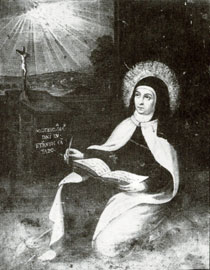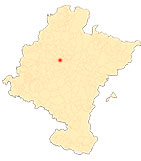pathway Teresian in Pamplona
Other paintings in the Discalced Carmelite monasteries
The fact that the convent of the Descalzos was not abandoned after the execlaustration and was inhabited by the Descalzas during the second half of the 19th century made it possible to conserve numerous paintings that have survived to the present day, many of them of Teresian content and more specifically alluding to their transverberation. Among them is the one that signatureby Díaz Ferreras of Valladolid in 1672 and is kept in the church's Wayside Cross, which suffers from a certain staticism despite the baroque style of topic. In the antechorus of the same convent is another canvas by the same artist topicfrom the last third of the 17th century, which has similarities with the work of the Madrid painter Francisco de Lizona and shows us the saint in a theatrical composition that the painter Vicente Berdusán would make his own, disseminating it in his works. On one of the half-point canvases in the corners of the cloister is another painting from the third quarter of the 17th century, inspired by one of the engravings in the Collaert-Galle series (1613).
Another painting, in this case on copper, is made with meticulous technique, is small in size (31 x cm.) and must be dated to the first half of the seventeenth century. It represents the saint getting ready to write with the spinning spindle at her feet, in a concession of the composition in favor of a passage of daily life, far from her ecstasies, raptures and idealizations so abundant in her iconography. It is a very popular version of what Father Jean de la Croix calls "the painting of Anne of Saint Bartholomew and its derivatives", whose original is in the Carmelites of Beaune (France) and according to the registration he has, it was a piece from which Mother Anne of Saint Bartholomew was not separated. Copies of the painting are in the Carmelites of Antwerp, where the mentioned religious died, in Kain (Belgium), Sens (France), the Incarnation of Avila, Guadalajara and the convents of Discalced of Rome. To its diffusion cooperated the fact that it was engraved in the fundamental part of its composition for the frontispiece of the Ceremonial of the Order in 1616.
-
FERNÁNDEZ GRACIA, R., "El convento e iglesia de los Carmelitas Descalzos de Pamplona. Architecture", Príncipe de Viana, 164, 1981, pp. 787-818.
-
ECHEVERRÍA GOÑI, P. and FERNÁNDEZ GRACIA, R., "El convento e iglesia de los carmelitas descalzos de Pamplona. Exorno artístico", Príncipe de Viana, 164, 1981, pp. 819-891.
-
AZANZA LÓPEZ, J. J., Arquitectura Religiosa Barroca en Navarra, Pamplona, Government of Navarre, 1996.
-
FERNÁNDEZ GRACIA, R., El retablo barroco en Navarra, Pamplona, Government of Navarre, 2003.
-
FERNÁNDEZ GRACIA, R., The Immaculate Conception in Navarre. Art and devotion during the centuries of the Baroque Mentors, artists and iconography. Pamplona, Eunsa, 2004.
-
FERNÁNDEZ GRACIA, R., Engraving, Counter-Reformation and Teresian Carmel. The collection of engravings of the Discalced Carmelites of Pamplona and Leonor de la Misericordia (Ayanz and Beaumont). Pamplona, I. G. Castuera, 2004.
-
FERNÁNDEZ GRACIA, R., "Santa Teresa", Juan de Goyeneche y el triunfo de los navarros en la Monarquía Hispánica del siglo XVIII, Pamplona, Fundación Caja Navarra, 2005, p. 352.
-
FERNÁNDEZ GRACIA, R., "Algunas esculturas napolitanas en Navarra", Pulchrum. Scripta in honorem Mª Concepción García Gainza, Pamplona, Government of Navarre, department de Cultura y Turismo-Institución Príncipe de Viana, 2011, pp. 300-310.
-
TARIFA CASTILLA, M. J., "Aparición de Cristo a Santa Teresa", Pamplona y San Cernin 1611-2011. IV Centenary of the Vow of the City, Pamplona, Pamplona City Council, 2011, p. 176.












